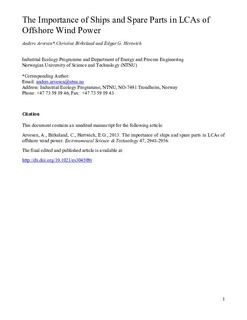| dc.contributor.author | Arvesen, Anders | |
| dc.contributor.author | Birkeland, Christine | |
| dc.contributor.author | Hertwich, Edgar G. | |
| dc.date.accessioned | 2017-11-08T14:40:46Z | |
| dc.date.available | 2017-11-08T14:40:46Z | |
| dc.date.created | 2013-05-21T12:21:55Z | |
| dc.date.issued | 2013 | |
| dc.identifier.citation | Environmental Science and Technology. 2013, 47 (6), 2948-2956. | nb_NO |
| dc.identifier.issn | 0013-936X | |
| dc.identifier.uri | http://hdl.handle.net/11250/2465021 | |
| dc.description.abstract | We develop and assess life cycle inventories of a conceptual offshore wind farm using a hybrid life cycle assessment (LCA) methodology. Special emphasis is placed on aspects of installation, operation, and maintenance, as these stages have been given only cursory consideration in previous LCAs. The results indicate that previous studies have underestimated the impacts caused by offshore operations and (though less important) exchange of parts. Offshore installation and maintenance activities cause 28% (10 g CO2-Eq/kWh) of total greenhouse gas emissions and 31–45% of total impact indicator values at the most (marine eutrophication, acidification, particulates, photochemical ozone). Transport and dumping of rock in installation phase and maintenance of wind turbines in use phase are major contributory activities. Manufacturing of spare parts is responsible for 6% (2 g CO2-Eq/kWh) of greenhouse gas emissions and up to 13% of total impact indicator values (freshwater ecotoxicity). Assumptions on lifetimes, work times for offshore activities and implementation of NOx abatement on vessels are shown to have a significant influence on results. Another source of uncertainty is assumed operating mode data for vessels determining fuel consumption rates. | nb_NO |
| dc.language.iso | eng | nb_NO |
| dc.publisher | American Chemical Society | nb_NO |
| dc.title | The Importance of Ships and Spare Parts in LCAs of Offshore Wind Power | nb_NO |
| dc.type | Journal article | nb_NO |
| dc.type | Peer reviewed | nb_NO |
| dc.description.version | acceptedVersion | nb_NO |
| dc.source.pagenumber | 2948-2956 | nb_NO |
| dc.source.volume | 47 | nb_NO |
| dc.source.journal | Environmental Science and Technology | nb_NO |
| dc.source.issue | 6 | nb_NO |
| dc.identifier.doi | 10.1021/es304509r | |
| dc.identifier.cristin | 1029392 | |
| dc.relation.project | Norges forskningsråd: 206998 | nb_NO |
| dc.relation.project | Norges forskningsråd: 209697 | nb_NO |
| dc.description.localcode | © American Chemical Society 2013. This is the authors accepted and refereed manuscript to the article. | nb_NO |
| cristin.unitcode | 194,64,25,0 | |
| cristin.unitname | Institutt for energi- og prosessteknikk | |
| cristin.ispublished | true | |
| cristin.fulltext | postprint | |
| cristin.qualitycode | 2 | |
